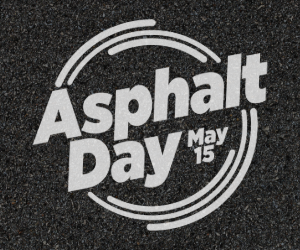
In 1987, the Strategic Highway Research Program (SHRP) was established to improve the performance and durability of roads in the U.S. Superpave (Superior Performing Asphalt Pavements) was a product of that research effort. Superpave?s system improves asphalt pavement performance by minimizing distresses such as rutting, low temperature cracking and fatigue cracking.
Today, Superpave’s Performance Graded (PG) asphalt binder specification is widely used. In the U.S., it (AASHTO M320) is the most widely used specification defining the properties of an asphalt binder. Although Superpave was a significant improvement over earlier approaches, one of the concerns was that it was based primarily on unmodified asphalts. Many industry and agency experts have discussed and debated the applicability of the specification for modified binders since it was introduced.
So, there has been an ongoing series of refinements and adjustments to AASHTO M320 since its introduction. In particular, the permanent deformation or rutting criteria, the fatigue cracking and the low-temperature cracking aspects of the specification have been reviewed. This article summarizes some of the latest developments in refining the PG asphalt binder system.
Improved high-temperature performance predictions
The use of polymer-modified asphalts to reduce pavement rutting has grown steadily since the late 1980s. To ensure that the modified binders contain polymer, a number of tests have been introduced as additions to the PG specification. Some of these “PG-plus” tests do not measure performance enhancements but simply indicate the presence of a particular type of modifier.
The Multi-Stress Creep Recovery (MSCR) test was developed as a potential replacement for the original M320 high temperature test and to replace the various PG-plus tests. It is designed to be performance related (rather than empirical) and to be blind to the type of modifier used. Both neat (unmodified) and modified binders were tested in the development of the MSCR test. It uses the dynamic shear rheometer (DSR) procedure to measure the stress/strain response of short-term aged binders.
The MSCR test (published as AASHTO TP70) applies a one second loading with a nine second recovery period over stress levels, 0.1 and 3.2 kPa for 10 cycles for each of the stress levels. The MSCR test starts at the lowest stress level and increases to the higher level at the end of 10 cycles, with no time delay between cycles. The average non-recoverable strain for the creep and recovery cycles is divided by the applied stress for those cycles to yield the non-recoverable creep compliance, Jnr.
Numerous evaluations of the MSCR test have shown that it is able to measure the difference in rutting potential of various modified and unmodified asphalt binders. These evaluations were performed on several types of mixes using a number of evaluation means, including loaded wheel test devices, accelerated load testers and actual pavement sites. For neat binders, a Jnr of 4.0 kPa-1 at 3.2 kPa shear stress provides binders with equivalent stiffness to binders meeting the existing PG specification.
Refinements to grade bumping
Polymer-modified binders are typically used in pavements with high traffic volume and/or heavy loads. Under the existing approach to binder selection, grade bumping is used to select stiffer or stronger binders to reduce the potential for rutting of these high stress pavements. For these cases, binders with a higher temperature grade would be selected.
For example, in a PG 64 climate, a pavement with a 30 million ESAL design level would be bumped up to a PG 70 and to a PG 76 for intersections and other high stress areas such as those having slowed and/or stopped traffic. With the grade-bumping approach, the specification criteria remain the same but the test temperature at which the criteria are applied is increased. The asphalt binder is tested at temperatures the pavement is not likely to actually experience.
The grade bumping approach is based on the assumption that each 6º C bump will correspond with a doubling of the stiffness of the binder. This assumption is not accurate because all binders do not have the same temperature susceptibility.
A new high-temperature binder specification would require the Jnr value, determined at a shear stress of 3.2 kPa, to have a maximum value of 4.0 kPa-1. For heavy traffic the Jnr is reduced to 2.0 kPa-1 and for worst-case traffic conditions (stopped, etc.), the Jnr would be limited to 1.0 kPa-1. The terminology would also be changed to move away from increasing the high temperature designation. For example, the standard grade would be designated as a PG 64S-XX, the slow or heavy traffic grade binder would be designated a PG 64H-XX, and the worst-traffic-case binder would be designated a PG 64V-XX.
In addition to the Jnr’s ability to predict rutting potential, the MSCR test can be used to determine the percentage of recovery (MSCR Recovery) during testing. This property provides an indication of the delayed elastic response of the binder. A high response value indicates a significant elastic component.
Intermediate temperature
In addition to developing a better relationship between high temperature binder properties and rutting, considerable research has been done to identify an improved binder fatigue test. Several studies have shown that Superpave’s intermediate temperature parameter, G*sin ∂, correlates poorly with asphalt mixture fatigue. This parameter is measured after a relatively small number of load cycles and the non-linear behavior or damage is not apparent. Work done under the NCHRP 9-10 research project used the time sweep test to apply sufficient cycles to induce damage, but the amount of time required to perform the test was a problem.
So, more recent efforts have been geared to developing accelerated fatigue procedures. One of the new procedures being considered to characterize fatigue cracking performance of asphalt binders is the Linear Amplitude Sweep (LAS) test. It is a relatively fast test, but it has some serious mechanics and calculations backing it up. The LAS test is performed on aged asphalt binder at an appropriate intermediate temperature using a frequency sweep test to generate rheological properties and a stepped shear strain amplitude test to generate accumulated damage in the asphalt binder sample.
The LAS test can be performed on the newer DSRs with a total testing time of about 12 minutes (the relatively fast and easy part). Then the data is exported to a spreadsheet and the viscoelastic continuum damage (VECD) approach is used to calculate the fatigue resistance of the binder (the serious mechanics and calculation part).
Cold temperature
In cold conditions, as the temperature drops, an asphalt binder contracts more than the aggregate in an asphalt pavement. This shrinkage causes thermal stresses and when these stresses exceed the tensile strength of the mixture, a low temperature crack forms.
The PG system uses data from the Bending Beam Rheometer (BBR) to measure the creep stiffness, S, of an asphalt binder. To prevent thermal cracking, the S value was limited to a maximum of 300 MPa. The rate at which the binder stiffness changes with time at low temperatures is regulated through the m-value. The direct tension test (DTT) was included in M320 as an alternate to using S and m-value. The DTT pulls an asphalt specimen in tension at a very slow rate to simulate shrinkage as a pavement cools. From this test, the “critical cracking temperature” can be determined.
Like the high and intermediate temperature properties, cold temperature characterization is being refined to address limitations that have been identified in the existing procedures. The Asphalt Binder Cracking Device (ABCD), proposed by Dr. Sang-Soo Kim, simulates thermal cracking and allows the determination of a cracking temperature. Another cold-temperature test, the Single Edge Notched Bend (SENB) test, uses fracture-mechanics based principles to determine a fracture toughness value (KIc). Another procedure being evaluated is the Double Edged Notched Tension (DENT) test.
Conclusion
The introduction of the Superpave asphalt binder system was a major step forward in characterizing the behavior of asphalts. With the refinements underway, the PG system is continuing to be improved.
Recommendation for MSCR implementation
The Asphalt Institute (AI) believes the MSCR test and specification are improvements to the current PG system that will allow for better characterization of the high-temperature performance-related properties of asphalt binders. AI encourages user agencies to make the transition to the test (AASHTO TP70) and specification (AASHTO MP19).
To aid in this transition, AI and the FHWA have developed several documents, available on AI’s website at www.asphaltinstitute.org under “Engineering.”














